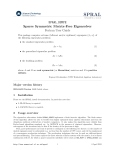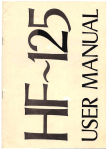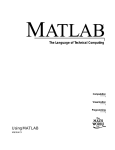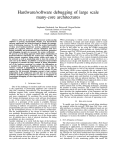Download QARPACK: Quadratic Arnoldi Package v.2. User's Guide.
Transcript
QARPACK: Quadratic Arnoldi Package v.2. User’s Guide. Marta M. Betcke∗ July 15, 2013 1 What is QARPACK? QARPACK is a MATLAB Toolbox for computing eigenvalues with real part in a specified interval and the corresponding eigenvectors of a large sparse quadratic or nonlinear eigenvalue problem (QEP/NEP). For QEPs QARPACK uses following two forms: (λ2 M + λC + K)x = 0, x 6= 0, (1) or (−ω 2 M + iωC + K)x = 0, x 6= 0. (2) The second form can be obtained from (1) through a substitution, λ = iω. (1) is in general preferable when the eigenvalues λ have a dominant real part, while (2) when λ have a dominant imaginary part, hence ω have a dominant real part again. From version v.1.9 QARPACK also contains NRA a solver for general nonlinear eigenvalue problems k X fi (λ)Ai x = 0, x 6= 0. (3) i=1 From version v.2.0 NRA also supports multiple eigenvalues. ∗ Department of Computer Science, University College London, Malet Place, London WC1E 6BT, UK. Email: [email protected] 1 QARPACK implements three iterative methods which directly act on the QEP/NEP avoiding prior linearization (and hence doubling of the problem size in case of QEP): QRA: Quadratic Restarted Arnoldi (M.M. Betcke, H. Voss, 2011, [1]) QARN: Q-Arnoldi for QEP (K. Meerbergen, 2001, [2]) NRA: Nonlinear Restarted Arnoldi (M.M. Betcke, H. Voss, 2011, [1]) All methods utilise local restarts to enable computation of a large number of the eigenvalues with the real part in an interval in the interior of the spectrum in one go. QRA accepts both QEP forms, QARN accepts only form (2) and NRA accepts only form (3). Furthermore, as not all QEP are formulated respecting the dominant direction in the spectrum, it may be necessary to reformulate the QEP to obtain the desired result, as explained in Section 4. In the essence, the methods will perform best if there is a dominant direction in the eigenvalue distribution in the complex plain e.g. the eigenvalues have a dominant part (real or imaginary). See the associated publications, [2, 1], for more insight on methods in QARPACK. 2 Installation QARPACK is hosted at http://www.cs.ucl.ac.uk/staff/M.Betcke/codes/qarpack/ The basic functionality requires only MATLAB and should be compatible with any reasonably recent release. The external preconditioners like e.g. PARDISO or AMG have to be obtained and installed separately. Untar the contents of the package into the preferred location tar -xzf qarpack.tar.gz This will create a top level directory ”qarpack” with the following content: qarpack/ qarpack/qra.m qarpack/nra.m qarpack/qarn.m 2 qarpack/qoptions.m qarpack/demo_qarpack_nlevp.m qarpack/plot_ev_conv.m qarpack/unique_ev.m qarpack/nlevp2nep.m qarpack/nep2str.m qarpack/nep_a_times_fi.m qarpack/README.txt qarpack/COPYING.txt qarpack/gpl-3.0.txt qarpack/private/ qarpack/private/gmres_jd.m qarpack/private/lline.m qarpack/private/permschur.m qarpack/private/precondition_AMG.m qarpack/private/precondition_LU.m qarpack/private/precondition_UMFPACK.m qarpack/private/precondition_PARDISO.m qarpack/doc/QARPACK_User_Guide.pdf Add the full path to ”qarpack” folder to your MATLAB path. 3 Interface to external preconditioners Apart from the MATLAB LU factorisations (LU: built-in P A = LU , UMFPACK: P AQ = LU ), QARPACK provides interface to two external preconditioners: • Sparse LU factorization, PARDISO http://www.pardiso-project.org You will also need to download and compile PARDISO Matlab interface by Peter Carbonetto available from the same website. Check PARDISO User’s Guide for detailed instructions. • MATLAB implementation of Algebraic Multigrid by Jonathan Boyle. This code is not publicly available. If you are interested in using 3 this AMG preconditioner please send your enquiry to David Silvester d.silvester at manchester.ac.uk. It is however our experience that LU decomposition performs superior to AMG for computation of the eigenvalues in the interior of the spectrum. You can create an interface to any other preconditioner by implementing a function with an interface precondition_PREC(mode, A, pole, prec_params, res) following the included examples for LU, UMFPACK, PARDISO and AMG. The function should implement four modes: "init", "compute", "apply", "finalize" 4 Reformulating a QEP The methods in QARPACK internally use the ordering the eigenvalues by their increasing real part, when advancing through the spectrum. Thus, the best results will be obtained if the eigenvalues of the QEP/NEP distribute along the real axis, or at least have a dominant real part. This imposes no restriction on what the methods can do, just it may require reformulating of your original QEP/NEP in one of the ways described below. The quadratic methods load the QEP directly from the provided file. QRA accepts both forms of QEP while QARN only accepts QEP in form (2). Transformation between QEP form (1) λ2 M x + λCx + Kx = 0, and QEP form (2) ˜ x + iω Cx ˜ + Kx ˜ =0 −ω 2 M i <(λ) dominant ↔ (1) → (2): λ = ω, (2) → (1): ω = λ, <(ω) dominant: ˜ = M, G ˜ = iG, K ˜ = −K M ˜ , G = −iG, ˜ K = −K ˜ M =M ii =(λ) dominant ↔ <(ω) dominant: ˜ = M, G ˜ = G, K ˜ =K (1) → (2): λ = iω, M ˜ ˜ ˜ (2) → (1): ω = −iλ, M = M , G = G, K = K 4 Transformation between QEP of the same form i.e. either both in form (1): λ2 M x + λCx + Kx = 0, with dominant =(λ) to ˜ x + ω Cx ˜ + Kx ˜ = 0, with dominant <(ω), ω2M or both in form (2) −λ2 M x + iλCx + Kx = 0, with dominant =(λ) to ˜ x + iω Cx ˜ + Kx ˜ = 0, with dominant <(ω) −ω 2 M iii =(λ) dominant → <(ω) dominant: ˜ = M, G ˜ = −iG, K ˜ = −K λ = iω, M 5 Describing NEP The general nonlinear eigenvalue solver NRA requires a structure describing the nonlinear eigenvalue problem (3) nep.k: number of additive terms nep.Ai: matrix coefficients nep.fi: functions of eigenvalue nep.dfi: derivative of fi nep.pcoeff: preconditioner weights nep.n: size of Ai nep.type: {” = ’generic’, ’quadratic’}: type of the NEP nep.prop: {”, ’symmetric’,’skewsymmetric’}: properties of the matrix coefficients 5 The preconditioner weights are used to set up the preconditioner P ≈ k X !−1 pi Ai fi (σ) . (4) i=1 The type of NEP determines the solver for projected problems. If NEP type is ’quadratic’ the linearization will be used. In general case we use the safeguarded iteration. The properties of the coefficient matrices are used for efficient projection. The NEP can be reformulate from imaginary to real dominant eigenvalues using the same transformation as for QEP λ = iω. 6 QARPACK functionality The core of QARPACK are three iterative projection methods for computation of eigenvalues with a real part in a specified interval, NRA, its quadratic version QRA and QARN. Furthermore some auxiliary routines are provided including interfaces to external preconditioners and some visualisation methods. 6.1 QRA: Quadratic Restarted Arnoldi QRA/NRA utilises the min-max characterisation the eigenvalues of the QEP or NEP to number eigenvalues. Once numbered the eigenvalues are processed one after another, minimising the risk of missing out eigenvalues. To be able to handle eigenvalues in the interior of the spectrum local eigenvalue numbering w.r.t. a chosen anchor eigenvalue have been introduced. The local numbering can be temporarily disturbed by spurious eigenvalues, which are eigenvalues on their way to their appropriate place in the spectrum but outside of the interval corresponding to the current search subspace. QRA/NRA has safeguards in place to recognise spurious eigenvalues and effectively drive them out of the search subspace are restore the local numbering. QRA/NRA will restart whenever the search subspace dimension exceeded a specified threshold, or convergence become to slow. At the restart the anchor is reset to one the previously computed eigenpairs, and the search continues for the eigenvalues with the real part larger than the anchor eigenvalue building a new search subspace. 6 [X, cosX, lambda, resvec, hit, lu_counter, lu_hit, time_comps, time_nonlins, time_lus, flag, iter_dim, la_hist, la_hist_hit] = qra(data_file, anchor, vanchor, up_bound, problem_type, scale, inverted, max_dim, solver, max_iter, prec_params, opt); Nonlinear Arnoldi/Jacobi Davidson with local restarts for the solution of a quadratic eingevalue problem (QEP) in a form -lambda^2*M*x + i*lambda*C*x + K*x = 0, (opt.QEP_FORM = 1) for eigenvalues (i*lambda) i,e. with dominant imaginary part or lambda^2*M*x + lambda*C*x + K*x = 0, (opt.QEP_FORM = 0) for eigenvalues lambda with dominant real part. The projected problems are solved by linerization. The residual norm ||T(lambda)x||/||x|| < RES_TOL is used as a stopping criterium. The local restarts use a chosen eigenpair, called an anchor, to introduce a local numbering in the subspace relatively to the anchor. During the iteration the local numbering can be distorted by "spurious" eigenvalues. The spurious eigenvalues are handled by the following deliberate iteration. The computed eigenvalues are identified in the search subspace and the not matching values are checked if they are "spurious" or genuine previously missed out eigenvalues by computing their residual norm. The first found "spurious" eigenvalue is iterated i.e. its residual is used to expand the search subspace until the subspace is cleared from the "spurious" eigenvalues or the previously missed eigenvalue has converged and the local numbering is restored. In this way a direct effort is made to accelerate the convergence of a spurious eigenvalue to drive it away from the subspace corresponding to (anchor, nr(last computed eigenvalue)+1) or to detect it unambiguously as a previously missed eigenvalue and include on its right position into the search subspace. Restart can be triggered 1. exceeding the maximal margin, opt.MAX_DIM_MARG 2. slow convergence rate by: subspace dimension, approached within a specified to avoid restarts while an eigenvalue is iterated of the residuals (see opt.CONV_RATE_TOL) When self scheduleding of restarts is enabled the algorithm measures the CPU time spent in average on an eigenvalue pair computation up to now 7 and registers whether the iterated eigenpair takes longer than the average time pro eigenpair or not, by counting up or down if too slow, toolong_counter = toolong_counter + 1, else toolong_counter = max(toolong_counter-1, 0) If toolong_counter exeeeds allowed number opt.TOOLONG, restart is triggered. @Input: datafile anchor vanchor up_bound problem_type scale inverted max_dim - name of the file with the matrices M, C (or G), K, for QEP in the form: -lambda^2*M*x + i*lambda*C*x + K*x = 0 for i*lambda - eigenvalues dominated by their imaginary part (set opt.QEP_FORM = 1) or lambda^2*M*x + lambda*C*x + K*x = 0 for lambda - eigenvalues dominated by their real part (set QEP_FORM = 0) - a known eigenvalue (an anchor) or a lower bound on the first wanted eigenvalue. In the latter case the first eigenpair will be iterated to convergence and then it will be used as an anchor. If a multiple eigenvalue is specified as an achor, the computed eigenpairs will include none of the eigenvectors corresponding to the (multiple) anchor - eigenvector corresponding to the anchor, if empty the first eigenpair (lambda, x) with real(lambda) >= anchor will be iterated to convergence and then it will be used as an anchor. The same measure is taken if the residual of the anchor pair is not small enough. - upper bound for wanted eigenvalues - type of QEP: {’gyroscopic’, ’symmetric’, ’quadratic’}. If no C or G exists, we set G = 0 and problem is relabelled ’linear’ but it is computationally treated as quadratic. - scale the eigenvalues of the QEP: (new eigenvalue) = scale * (old eigenvalue) - {0, 1} do not/do use the reversal of the polynomial, which is equivalent to the problem obtained through substitution lambda <- (-1/lambda) for opt.QEP_FORM = 1, M*x + i*lambda*C*x - lambda^2*K*x = 0 or M*x + lambda*C*x + lambda^2*K*x = 0 with lambda <- (1/lambda) for opt.QEP_FORM = 0 - maximal size of the searche subspace. If exeeded a restart is triggered 8 solver opt - the solver used for the subspace expansion ’arn’: Residual Inverse Iteration (RII), ’iter’: RII with GMRES instead of a direct solve, ’jd’: Jacobi Davidson - maximal iteration number, if exeeded the algorithms will terminate regardless of its state - preconditioner parameters structure: type: ’LU’ (default), ’AMG’, ’PARDISO’, ’UMFPACK’ For LU, UMFPACK and PARDISO: reorder: reordering algorithm for A, returning p such that A(p,p), e.g. @symamd, @symrcm, [] no reordering (default) diag_scale: 0 - none, 1 - left, 2 - right (default) For LU only: tol: tolerance for LU preconditioner if Inf then LU is used (default), otherwise an incomplete LU with specified tolerance tol is used For AMG (code by J. Boyle, not included): tol: tolerance for amg_solver (default opt.RES_TOL), diag_scale: 0 - none, 1 - left, 2 - right (default) maxit: maximal number of iterations of the iterative solver (default opt.JD_GMRES_MAXIT) amg_smoother: ’PDJ’ (default), ’PGS’ amg_solver: @minres, @pcg, @gmres (default) reuse_mg: number of times the same multi grid is reused (default 0 do not reuse preconditioner) restart: as in e.g. gmres, set [] for no restarts (default) Default the complete matlab ’LU’ - further options for the solver, see qoptions.m @Output: X cosX lambda resvec hit lu_counter lu_hit time_comps - max_iter prec_params eigenvectors cosines of angles between the consecutive eigenvectors eigenvalues, ordered by the real part residual norm history numbers of iteration at which eigenvalues converged number of (incomplete) LU factorizations numbers of iteration when the preconditioner was recomputed computation time recorded after every converged eigenvalue, the last entry contains total time 9 time_nonlins - time spent on solving of projected eigenvalue problems recorded after every converged eigenvalue, reset at restart time_lus - CPU times for computation of new preconditioners flag - outcome of the algorithm 0 - the upper bound have been reached, 1 - iteration exited prematurely i.e. the limit of iterations has been reached. The stopping criterium is not satisfied but some eigenvalues converged 2 - iteration exited prematurely i.e. the limit of iterations has been reached. The stopping criterium is not satisfied and no eigenvalue converged so far iter_dim - search subspace dimension at each iteration la_hist - history of eigenvalue convergence (it records convergence of multiple copies of the same eigenpair) la_hist_hit - number of iterations at which an eigenpair converged (possibly a copie of already converged value) restart_cause - records the cause for the restart as sum of 1000: emergency restart (opt.MARG, 100 : search space dimension exeeded, 10 : slow convergence rate of the residual norms, 1 : self scheduling triggered restart (average convergence time pro eigenpair exeeded too often) 6.2 NRA: Nonlinear Restarted Arnoldi NRA can be applied to general nonlinear eigenvalue problems, while QRA is an implementation limited to the quadratic case by the choice of the solver for the projected problem. [X, cosX, lambda, resvec, hit, lu_counter, lu_hit, time_comps, time_nonlins, time_lus, flag, iter_dim, la_hist, la_hist_hit] = nra(nep, anchor, vanchor, up_bound, max_dim, solver, max_iter, prec_params, opt); Nonlinear Arnoldi/Jacobi Davidson with local restarts for the solution of a nonlinear eingevalue problem (NEP) of a form T(lambda) x = sum_i fi(lambda) Ai x = 0 The projected problems are solved for general problems with safeguarded iteration and for quadratic problems with linearization. The residual norm ||T(lambda)x||/||x|| < RES_TOL is used as a stopping criterium. 10 The local restarts use a chosen eigenpair, called an anchor, to introduce a local numbering in the subspace relatively to the anchor. During the iteration the local numbering can be distorted by "spurious" eigenvalues. The spurious eigenvalues are handled by the following deliberate iteration. The computed eigenvalues are identified in the search subspace and the not matching values are checked if they are "spurious" or genuine previously missed out eigenvalues by computing their residual norm. The first found "spurious" eigenvalue is iterated i.e. its residual is used to expand the search subspace until the subspace is cleared from the "spurious" eigenvalues or the previously missed eigenvalue has converged and the local numbering is restored. In this way a direct effort is made to accelerate the convergence of a spurious eigenvalue to drive it away from the subspace corresponding to (anchor, nr(last computed eigenvalue)+1) or to detect it unambiguously as a previously missed eigenvalue and include on its right position into the search subspace. Restart can be triggered by: 1. exceeding the maximal subspace dimension, approached within a specified margin, opt.MAX_DIM_MARG to avoid restarts while an eigenvalue is iterated 2. slow convergence rate of the residuals (see opt.CONV_RATE_TOL) 3. When self scheduleding of restarts is enabled the algorithm measures the CPU time spent in average on an eigenvalue pair computation up to now and registers whether the iterated eigenpair takes longer than the average time pro eigenpair (multiplied by opt.ALPHA) or not, by counting up or down if too slow, toolong_counter = toolong_counter + 1, else toolong_counter = max(toolong_counter-1, 0) If toolong_counter exeeeds allowed number opt.TOOLONG, restart is triggered. This version supports multiple eigenvalues. @Input: nep anchor - data structure containing matrix and function coefficients of NEP T(lambda)*x = sum_i nep.fi{i}(lambda)*nep.Ai{i}*x = 0 - a known eigenvalue (an anchor) or a lower bound on the first wanted eigenvalue. In the latter case the first eigenpair will be iterated to convergence and the bound will be used 11 vanchor up_bound max_dim solver max_iter prec_params opt as an anchor. If a multiple eigenvalue is specified as an achor, the computed eigenpairs will include all of the eigenvectors corresponding to the (multiple) anchor - eigenvector corresponding to the anchor, if empty the first eigenpair (lambda, x) with real(lambda) >= anchor will be iterated to convergence and the bound will be used as an anchor. The same measure is taken if the residual of the anchor pair is not small enough. - upper bound for wanted eigenvalues - maximal size of the searche subspace. If exeeded a restart is triggered - the solver used for the subspace expansion ’arn’: Residual Inverse Iteration (RII), ’iter’: RII with GMRES instead of a direct solve, ’jd’: Jacobi Davidson - maximal iteration number, if exeeded the algorithms will terminate regardless of its state - preconditioner parameters structure: type: ’LU’ (default), ’AMG’, ’PARDISO’, ’UMFPACK’ For LU, UMFPACK and PARDISO: reorder: reordering algorithm for A, returning p such that A(p,p), e.g. @symamd, @symrcm, [] no reordering (default) diag_scale: 0 - none, 1 - left, 2 - right (default) For LU only: tol: tolerance for LU preconditio ner if Inf then LU is used (default), otherwise an incomplete LU with specified tolerance tol is used For AMG (code by J. Boyle, not included): tol: tolerance for amg_solver (default opt.RES_TOL), diag_scale: 0 - none, 1 - left, 2 - right (default) maxit: maximal number of iterations of the iterative solver (default opt.JD_GMRES_MAXIT) amg_smoother: ’PDJ’ (default), ’PGS’ amg_solver: @minres, @pcg, @gmres (default) reuse_mg: number of times the same multi grid is reused (default 0 do not reuse preconditioner) restart: as in e.g. gmres, set [] for no restarts (default) Default the complete matlab ’LU’ - further options for the solver, see qoptions.m 12 @Output: X cosX lambda resvec hit lu_counter lu_hit time_comps - time_nonlins time_lus flag iter_dim la_hist - la_hist_hit - restart_cause - 6.3 eigenvectors cosines of angles between the consecutive eigenvectors eigenvalues, ordered by the real part residual norm history numbers of iteration at which eigenvalues converged number of (incomplete) LU factorizations numbers of iteration when the preconditioner was recomputed computation time recorded after every converged eigenvalue, the last entry contains total time - time spent on solving of projected eigenvalue problems recorded after every converged eigenvalue, reset at restart - CPU times for computation of new preconditioners - outcome of the algorithm 0 - the upper bound have been reached, 1 - iteration exited prematurely i.e. the limit of iterations has been reached. The stopping criterium is not satisfied but some eigenvalues converged 2 - iteration exited prematurely i.e. the limit of iterations has been reached. The stopping criterium is not satisfied and no eigenvalue converged so far search subspace dimension at each iteration history of eigenvalue convergence (it records convergence of multiple copies of the same eigenpair) number of iterations at which an eigenpair converged (possibly a copie of already converged value) records the cause for the restart as sum of 1000: emergency restart (opt.MARG, 100 : search space dimension exeeded, 10 : slow convergence rate of the residual norms, 1 : self scheduling triggered restart (average convergence time pro eigenpair exeeded too often) QARN: Quadratic Arnoldi QARN utilises the partial Schur form of the linearization of the QEP to lock the converged eigenvalues thereby preventing repeated convergence of the same eigenvalues. It does so without doubling the size of the problem, since all the computations are directly executed on the original QEP matrices. 13 Traversing of the complex plane is achieved by choosing a new pole with a larger real part then the current one, which lets the algorithm systematically work through the interval containing the real part of the wanted eigenvalues. QARN will restart whenever, the search subspace becomes to large. If the restart subspace is not large enough to accommodate all the wanted eigenvalues, some of the locked eigenvalues will have to be purged. To this end the partial Schur form is rearranged, locking the eigenvalues closest to the current pole, and purging the eigenvalues farther away. This systematic motion of the pole in the interval, makes the algorithm progress through the spectrum along the real axis. However, there is no guarantee that the eigenvalue will not converge multiple times or that it will not be missed out if the new pole has been chosen to far from the current one. QARN is limited to quadratic eigenvalue problems. [X, lambda, resvec, hit, lu_counter, poles, hit_poles, time_comps, time_nonlins, time_lus, flag] = qarn(data_file, sigma, start_vector, stop_crit, problem_type, scale, inverted, max_subspace, restart_sub, solver, max_iter, prec_params, opt, noisy); Solves the quadratic eigenvalue problem (QEP): Q(lambda)x = 0 with Q(lambda) = -lambda^2*M + i*lambda*C + K. using Q-Arnoldi method (Meerbergen, 2001) for nr_ev_wanted eigenvalues nearest to the pole sigma or eigenvalues smaller than a given upper bound. This QEP form is particularly suited for problems with eigenvalues with dominant imaginary part and can be obtrained from a standard T(omega) = omega^2*M + omega*C + K through a substitution: omega <- i*lambda. Notice, that after the reformulation the eigenvalues of Q(lambda) have a dominant real part. Local restarts are implemented to enable the algorithm to compute all wanted eigenvalues with the real part in an interval in the spectrum in one go. The algorithm uses partial Schur form to lock and purge eigenvalues. If the is not large enough to accomodate all the computed eigenvalues will have to form at the restart. 14 of the symmetric linearization dimension of the restart subspace the wanted eigenvalues, some of be purged from the local Schur Every opt.POLE_CHANGE iterations (see qoptions.m for more details), the algorithm will select a new pole with a real part larger than this of the current pole. Thus the algorithm works its way from the left to the right along the real axis. Therefore, if a large number of eigenvalues is required, the initial pole should be chosen close to the left end of the interval containing the wanted eigenvalues. Whenever, a new pole is computed the local Schur form is reordered, so that the eigenvalues closest to the pole are in the left upper corner. The eigenvalues closest to the current pole (see opt.LOCK_TYPE for definitions of closeness) are kept in the subspace after restart. It makes sense to let the restarts coincide with the pole change and the preconditioner change i.e. to choose k*opt.POLE_CHANGE = max_subspace = j*opt.PREC_CHANGE, with k,j integer multiples. As with iterative algorithms in general, eigenvalues may be overlooked. @Input: data_file sigma start_vector stop_crit problem_type - name of file with the matrices K, G (or C), M of the QEP in form: -lambda^2*M*x + i*lambda*C*x + K*x = 0, or -lambda^2*M*x + i*lambda*G*x + K*x = 0 - initial pole value (pick on the lower end of the real part of the spectrum) - initial vector, if empty a random vector is used - number of wanted eigenvalues or an upper bound on the real part of the eigenvalues as specified by opt.STOP_COND, {0: number, 1: upper bound} - structure of the QEP: {’quadratic’, ’gyroscopic’, ’symmetric’}. The structure in only enforced at Q(alpha) times vector product. This is not rigorous, and can slow down convergence. In the latter case disregard the structure and revert to the general unstructured problem choosing ’quadratic’ If no C or G exists, we set C = 0 and the problem is relabeled ’linear’ but still computationally treated as quadratic, see eigs.m for linear solver 15 scale inverted max_subspace restart_sub solver max_iter prec_params - scale the eigenvalues: (new eigenvalue) = scale * (old eigenvalue) i.e. solve. Q(lambda) = -lambda^2*M + i*lambda*scale*C + scale^2*K If scale is empty, the quotient of 1-norms of K and M is used - {0, 1} do not/do compute with the inverted problem, obtained through a substitution: lambda<-(-1/lambda), resulting in: M*x + i*lambda*C*x - lambda^2*K*x = 0. The invertion is carried out after scaling. - maximal subspace dimension, if exeeded the restart is triggered - size of the subspace after restart. The search subspace at restart has to contain restart_sub vectors: restart_sub = opt.NOT_CONV_VEC_NR (not converged) + CONV_VEC_NR (locked). If restart_sub is large enough to accomodate all the wanted eigenvalues, no computed eigenvalues will be purged at restart. Otherwise, CONV_VEC_NR <= restart_sub locked vectors in addition to opt.NOT_CONV_VEC_NR not converge vectors closest to the pole will be kept in at restart and the rest will be purged - the solver used for the subspace expansion {’arn’ (LU), ’iter’ (GMRES), ’jd’ (Jacobi Davidson with GMRES)} - maximal iteration number, if exeeded the algorithm will terminate regardless of its state - For ’iter’ and ’jd’: preconditioner, leave empty for no preconditioning For ’arn’: subspace expansion operator, leave empty for the default Matlab LU direct solver. Preconditioner parameters structure: type: ’LU’ (default), ’AMG’, ’PARDISO’ , ’UMFPACK’ For LU, UMFPACK and PARDISO: reorder: reordering algorithm for A, returning p such that A(p,p), e.g. @symamd, @symrcm, [] no reordering (default) diag_scale: 0 - none, 1 - left, 2 - right (default) 16 opt noisy @Output: X lamda resvec hit lu_counter poles hit_poles time_comps time_nonlins time_lus For LU only: tol: tolerance for LU preconditioner if Inf then LU is used (default), otherwise an incomplete LU with specified tolerance tol is used For AMG (code by J. Boyle, not included): tol: tolerance for amg_solver (default opt.RES_TOL), diag_scale: 0 - none, 1 - left, 2 - right (default) maxit: maximal number of iterations of the iterative solver (default opt.JD_GMRES_MAXIT) amg_smoother: ’PDJ’ (default), ’PGS’ amg_solver: @minres, @pcg, @gmres (default) reuse_mg: number of times the same multi grid is reused (default 0 do not reuse preconditioner) restart: as in e.g. gmres, set [] for no restarts (default) Default the complete matlab ’LU’ - further options for the solver, see also qoptions.m - switch on the debbuging output. Set noisy {0 .. nr_ev_wanted eigenvalue}, to debug from noisy-th eigenvalue - eigenvectors - eigenvalues, in the order of convergence - residual norm history. At each iteration it contains the residual of either if any vector convereged, the last converged Schur vector, or the of first not converged Schur vector - for each eigenvalue it records the iteration at which the eigenvalue converged - number of times the preconditioner was recomputed (e.g. LU factorizations) - poles used throughout the computation. The method for choosing a new pole is specified by opt.POLE_TYPE - records the iteration number at which the pole has changed - total computation time recorded for every converged eigenvalue - computational time taken by Schur factorization and reordering, recorded for every converged eigenvalue - time for recomputing the preconditioner, recorded at 17 flag 6.4 - every preconditioner change 0 - the upper bound has been reached or the number of wanted eigenvalues have been computed 1 - iteration exited prematurely i.e. the limit of iterations has been reached. The stopping criterium is not satisfied but some eigenvalues converged 2 - iteration exited prematurely i.e. the limit of iterations has been reached. The stopping criterium is not satisfied and no eigenvalue converged so far Default Solver Options Routine qoptions.m will generate a default set of parameters for each of the solvers. opt = qoptions(solver, varargin) @Input: solver: choose the solver from {’nra’,’qarn’} for which the parameters are needed. Each of the solvers requires different subset of the parameters varargin: the default values of the parameters can be overwritten qoptions(’nra’, ’res_tol’, 1e-8) overwrites the default opt.res_tol value, and sets opt.res_tol = 1e-8 @Output: opt: structure containing the QEP solver parameters @Default solver parameters: Common parameters: Tolerance threshold for reorthogonalization ORTH_TOL = 1e-1; Residual norm tolerance RES_TOL = 1e-4; Relative threshold for the elimination of the imaginary part due to the roundoff error IMAG_TOL = 1e4*eps; Minimal relative gap between two (not multiple) eigenvalues. It is needed for finding spurious ev’s. 18 RGAP_TOL = 1e-5; Maximal number of iterations of GMRES used by ’jd’, ’iter’ (NRA) JD_GMRES_MAXIT = 15; No of GMRES iterations before restart, used with ’jd’ (QARN), ’iter’ GMRES_RESTART = 30; QRA/NRA parameters: Tolerance for the ratio of the last two residual norms. If it is not met a restart will be triggered. CONV_RATE_TOL = 0.5; Number of eigenvectors (corresponding to the eigenvalues closest to the anchor) which will be included into the search subspace V after the restart. LOCKED_VEC_NR = 0; The algorithm will try to restart whenever the subspace size reached max_dim - MAX_DIM_MARG to avoid restarts while an eigenpair converges. Then the restart is triggered immediately after an eigenvalue converged or after MAX_DIM_MARG iteration in any case. MAX_DIM_MARG = 5; Initial tolerance for the residual in JD algorithm. It will decrease during the iteration as: JD_TOL_FACT*JD_TOL JD_INIT_TOL = 0.5; JD_TOL_FACT = 0.75; Factor which modifies the RES_TOL when the relative distance of two computed eigenvalues is close to RGAP_TOL MULT_EV_RES_FACT = 50; Parameters for self scheduling of restarts: How often the average time pro eigenvalue in the entire cycle (multiplied by factor ALPHA) can be exceeded by the CPU time necessary for the current eigenvalue. Set TOOLONG large to disable self scheduling of restarts. TOOLONG = 1e4; ALPHA = 1; 19 Choose solver for projected problem, linearization type: {’L1’, ’L2’} PLIN = ’L2’; Choose the form of the QEP: {0,1} 0: Q(sigma) = sigma^2*M+sigma*G+K, for eigenvalues with dominant real part 1: Q(sigma) = -sigma^2*M+i*sigma*G+K, for eigenvalues with dominant imaginary part QEP_FORM = 1; Choose if the projected QEP is solved by QR or QZ algorithm {’QR’, ’QZ’} PSOLVER = ’QZ’; NRA only: Choose if the safeguarded iteration solves the EP: Tm(lambda) y = 0 or the GEP: Tm(lambda) y = mu Tm’(lambda) y = 0. If set the GEP will be solved. SG_DERIV = 1; QARN parameters: Choose stopping criterion from 0: eigenvalue number, 1: upper bound on the real part of the eigenvalue STOP_COND = 1; Tolerance for the iterative solver ITER_TOL = 1e-2; Maximal number of consecutive failures of the iterative solver used by ’jd’. Every time the solver fails new pole will be set to the current iterate, S(q+1,q+1). After MAX_FAIL_ITER-1 consecutive failures the tolerance ITER_TOL will be reduced to sqrt(ITER_TOL). If this does not help either the algorithm will terminate with an error message. MAX_FAIL_ITER = 3; 20 Keep the pole for this many iterations in the initial phase. It has to be larger then 1. If no pole change wanted, set to max_iter INIT_POLE_KEEP = 40; Relative distance wrt the largest distance to the pole in the search subspace. It is needed for POLE_TYPE = ’far_pole’ POLE_DIST = 1.2; For direct solve this is how frequently the LU of Q(sigma) is recomputed. For iterative solve this refers to the preconditioner. We use LU of real(K - sigma^2M) in both cases. For real K, M it is real anyway since we use real poles. Req: PREC_CHANGE >= POLE_CHANGE PREC_CHANGE = 80; How frequently the pole is adjusted for both direct and iterative solves. POLE_CHANGE = 20; In case no of wanted ev’s exceeds the restart subspace size some eigenvalues will be purged. NOT_CONV_VEC_NR specifies how many of the not converged vectors are kept after the pole has been changed. Hence, restart_sub-NOT_CONV_VEC_NR converged vectors are kept NOT_CONV_VEC_NR = 1; Strategy for the change of the pole {’far_pole’, ’next_ev’, ’none’} In each case the new pole has to be larger then the current one. The poles are real. If the choice of pole is not possible some fall-back values are used dependent on the chosen strategy. ’far_pole’: the pole is chosen between the not converged Schur values, at the distance at least POLE_DIST*(maximal distance among the locked vectors to the current pole) ’next_ev’ : the pole is chosen between the last converged value and the first not converged value. ’none’ : do not change the pole POLE_TYPE = ’next_ev’; Choose type of locking: ’sigma’: works through the Schur values closest to the pole, 21 locking the converged pairs. It stops when it encounters the first not converged pair. In general the absolute distance to the pole is used however, if in addition POLE_TYPE = ’next_ev’ it works through the Schur pairs from the closest to the pole in the increasing real part direction first, followed by the decreasing real part direction until it encounters an unconverged pair. ’residual’: locks all newly converged Schur vectors. The systematic moving through the spectrum is not forced. LOCK_TYPE = ’residual’; For JD: Choose Q projector type {’Z*R’, ’P*R’}. The first one is an oblique and less stable projector. The second is an orthogonal projector but it requires an extra reorthogonalization of the residual. Q_TYPE = ’Z*R’; For JD: Choose from {’omega’, sigma}. ’omega’: after initial INIT_POLE_KEEP iterations sigma in the Jacobi Davidson correction equation will be set to the current approximation. ’sigma’: sigma in the Jacobi Davidson correction equation will be chosen as the pole. SIGMA_TYPE = ’omega’; 6.5 Filtering out multiple copies of an eigenvalue QARN can find multiple copies of the same eigenvalue. A routine unique en.m is provided to identify eigenvalues equal up to a given tolerance. See also demo qarpack nlevp.m for examples how to use the function. [ulambda, iulambda, ifirst_conv] = unique_ev(lambda, TOL) Returns a vector of unique eigenvalues extracted from "lambda". The uniqueness is understood up to the specified "TOL". Two eigenvalues lambda1 and lambda2 are considered equal if abs(real(lambda2)-real(lambda1))/abs(lambda1) < TOL and abs(imag(lambda2)-imag(lambda1))/abs(lambda1) < TOL The vector of unique complex values "ulambda" is sorted by the real part first and within identical real part by 22 the imaginary part. "iulambda" gives the indices of the eigenvalues "lambda" in "ulambda" i.e. it holds: ulambda(iulambda) = lambda, up to the given tolerance TOL. Assuming that lambda is entered in their convergence order, "ifirst_conv" contains the indices of the first converged copy of each of the unique eigenvalues in "lambda" i.e. lambda(ifirst_conv) returns the first converged copies in lambda. 6.6 Visualisation For the visualisation of the performance of the methods the routine plot ev conv.m is provided. See demo qarpack nlevp.m for examples of how to use this function. plot_ev_conv(experiment, fig, REAL_FLAG) Plot eigenvalue and residual norm convergence history from results stored in the "experiment" file, into figures with numbers in "fig" (1x4 array). "REAL_FLAG" specifies which part of the spectrum is dominant, real (1) or imaginary (0). The file "experiment" has to contain the following outputs from one or both the methods with names precisely as below: QRA: lambda, la_hist, la_hist_hit, anchor_lambda, lu_hit, resvec, hit, restart_cause, optQRA NRA: lambda_n, la_hist_n, la_hist_hit_n, anchor_lambda_n, lu_hit_n, resvec_n, hit_n, restart_cause_n, optNRA QARN: lambda_q, poles_q, hit_poles_q, resvec_q, hit_q, optQARN 7 Acknowledgements and Credits Almost all of the code in QARPACK was written by Marta M. Betcke with the exception of 23 • permschur.m Schur form reordering, based on an M-File swapschur.m, which origin could not be determined QARPACK is released under the GNU Public License, as follows: QARPACK is a MATLAB implementation of two methods for solution of large sparse quadratic eigenvalue problems: NRA: Nonlinear Restarted Arnoldi (M.M. Betcke, H. Voss, 2011). QARN: Q-Arnoldi method (K. Meerbergen, 2001) Copyright (C) 2010 Marta M. Betcke QARPACK is free software: you can redistribute it and/or modify it under the terms of the GNU General Public License as published by the Free Software Foundation, either version 3 of the License, or (at your option) any later version. QARPACK is distributed in the hope that it will be useful, but WITHOUT ANY WARRANTY; without even the implied warranty of MERCHANTABILITY or FITNESS FOR A PARTICULAR PURPOSE. See the GNU General Public License for more details. You should have received a copy of the GNU General Public License along with this program. If not, see <http://www.gnu.org/licenses/>. If QARPACK helped you to generate results, please cite: [3, 1] References [1] M M Betcke and H Voss. Nonlinear Restarted Arnoldi: Interior Eigenvalue Computation. Institute of Numerical Simulation, Technical Report 157, 2011, https://www.mat.tu-harburg.de/ins/forschung/ rep/rep157.pdf [2] K Meerbergen. Locking and Restarting Quadratic Eigenvalue Solvers. SIAM Journal on Scientific Computing. 22 (5) pp. 1814-1839, 2001. [3] M M Betcke. QARPACK: Quadratic Arnoldi Package. User’s Guide. UCL, 2011, http://www.cs.ucl.ac.uk/staff/M.Betcke/codes/qarpack/ QARPACK_User_Guide.pdf 24




































